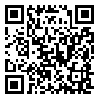1. Argyle, M. (1996). The social psychology of leisur. London: Routledge.
2. Argyle, M. (2001). The psychology of happiness. London: Routledg.
3. Azimi. S.& Fazelian. P. (2013). New trends and approaches in instructional design and technology. Procedia - Social and Behavioral Sciences, 82, 525 - 528. [
DOI:10.1016/j.sbspro.2013.06.303]
4. Berry, D. S., & Hansen, J.S. (1996). Positive asset, negative affect, and social interaction. Journal of Personality and Social Psychology, 71, 796-809. [
DOI:10.1037/0022-3514.71.4.796]
5. Buss, D. (2000). The evolution of happiness. American psychologist, 55, 15- 23. [
DOI:10.1037/0003-066X.55.1.15]
6. Byrd, k. R., Lear, D., & Schwenka, S. (2000). Mysticm as a predictor of subjective well-being, International Journal for the Psychology of Religion. 10, 259-269. [
DOI:10.1207/S15327582IJPR1004_04]
7. Diener, E., Oishi, S., & Tiandis, H. (1997). The shifting basis of life satisfaction judgements across cultures: Emotions versus norms. Journal of Personality and Social Psychology, 74, 482-93. [
DOI:10.1037/0022-3514.74.2.482]
8. Huppke, R. W . (2001). Study finds community work linked to happiness. retrieved 2012, from http://archive nando time.../ O, 2107, 500045722- 500698037-503784788- O, 00. html? Printe.
9. Kuller, R. C. (1992). Health and behavior of children in classrooms with and without windows. Journal of Environmental Psychology, 12, 305-317. [
DOI:10.1016/S0272-4944(05)80079-9]
10. Liaghatdar, M. J., Jafari, M., Abedi, M. R., & Samiee, F. (2008). Reliability and validity of the Oxford happiness inventory among university students in Iran. The Spanish Journal of Psychology, 11, 310-313. [
DOI:10.1017/S1138741600004340]
11. Lu, L., &. Argyle, M. (1991). Happiness and cooperation. Personality and Individual Differences, 2, 1019-1030. [
DOI:10.1016/0191-8869(91)90032-7]
12. Lykken, D. (1999). Happiness: What Studies on Twins Show us About Nature and Happiness Set Point. New York: NY: Golden Books.
13. Lyubomirsky, S. (2001). Why are some people happier than others? Psychologist, 56, 239-249. [
DOI:10.1037/0003-066X.56.3.239]
14. Myers, D. G. (2000). The friends and faith of happy people. American Psychologist, 12, 56-57. [
DOI:10.1037/0003-066X.55.1.56]
15. Phelan, R. (1998). The relationship between student and teacher perception of the organization climate of their school. Retrieved 2012, from http://www.lib. umi.com/ disserations/ previwe
16. Philips, D. L. (1967). Social participation and happiness. The Ameircan Journal of Sociology, 72, 479-488. [
DOI:10.1086/224378]
17. Reiss, S. (2001). Secrets of happiness. Psychology Today, 34, 50-55.
18. Rittner-Heir, R .M. (2002). Color and light in learning. School Planning and Management, 41, 57-58,60-61. [
DOI:10.1016/S0169-2046(02)00101-9]
19. Rose, R. (2000). How much dose social capital add to individual health? A survey study of Russians. Social Science & Medicine, 51, 1421-1435. [
DOI:10.1016/S0277-9536(00)00106-4]
20. Ross, C. E. (1989). Explaining the social patterns of depression: Control and problem-solving or support and talking. Journal of Health and Social Behavior, 30, 206-219. [
DOI:10.2307/2137014]
21. Ryan, R. M., & Deci, E. L. (2000). Self-determination theory and the facilitation of intrinsic motivation, social development, and well-being. American Psychologist, 55(1), PP. 68-78. [
DOI:10.1037/0003-066X.55.1.68]
22. Thompson, S. (2003). Color in education. School Planning and Management, 42, 30-32.





